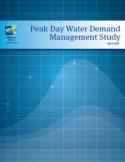Peak Day Water Demand Management Study

Grabbing a page from the energy efficiency playbook, a new report from the Alliance for Water Efficiency (AWE) describes an innovative load shifting experiment carried out during the summer of 2016 by New Jersey American Water (NJAW), Rachio, and WaterDM. The Peak Day Water Demand Management Study explores the viability of using remotely-controlled irrigation systems to reduce peak water demands and introduces a promising new approach.
The peak reduction concept and research design were developed by Margaret Hunter, Senior Project Manager at American Water, and while this experiment was a small-scale pilot study, the expanded implications are significant. Additionally, Peter Mayer, Principal and Founder of WaterDM, provided the analysis methodology and networking to support American Water in this research.
In the AWE study, fifteen NJAW customers, equipped with Rachio irrigation controllers, agreed to have their irrigation remotely interrupted on two separate dates in August 2016 for the experiment. Irrigation programs were successfully interrupted and resumed normal operation the following day, demonstrating the ability to precisely target specific sites and dates to shave peak demands. Based on historic water use records of the participants, an estimated total of 84 kgal of peak demand reduction occurred on each day of interruption.
“This research opens an exciting new chapter in urban water management where connected devices and partnerships with customers can be used to solve complex management problems, in this case summertime peak demands,” said Mary Ann Dickinson, President and CEO of the Alliance for Water Efficiency. “This pilot study is a small step in the direction of a more advanced approach to water demand management of urban water systems and AWE is proud to be at the forefront of this effort.”
Further analysis of historic irrigation patterns was undertaken to extrapolate the potential peak reduction that could be seen if this approach was implemented on a larger scale. The results of the analysis suggest that 1 MGD of irrigation reduction can be achieved with approximately 500 to 1,700 participants; reduction of 5 MGD can be achieved with approximately 2,500 to 8,600 participants; and a 10 MGD-reduction can be achieved with approximately 5,000 to 17,300 participants. Variability in landscape size, character, and irrigation system output necessitate a broad range estimate, particularly when extrapolating from a small sample. Future research will further refine these estimates.
The report concludes, “It is not enough to simply shut systems off one day and shift the load to the next, thus creating a different, but similarly large peak day. With thousands of enabled irrigation controllers in a system, much more sophisticated load shifting approaches become possible. In a fully developed water demand management system, urban irrigation could be orchestrated to match water production profiles during key parts of the summer. The system could also be used to remotely shutdown irrigation systems across a community or in specific neighborhoods during an emergency such as a water main break, a major fire, or an earthquake.”
“AWE research is driving innovation in the water and irrigation industries,” said Dickinson. “This project is a great example of our partnership approach and we are always looking for others to partner with.”





